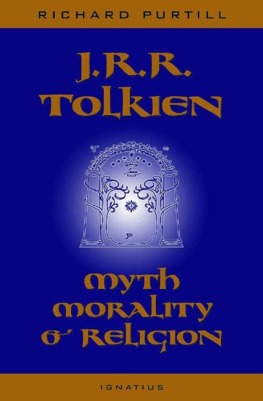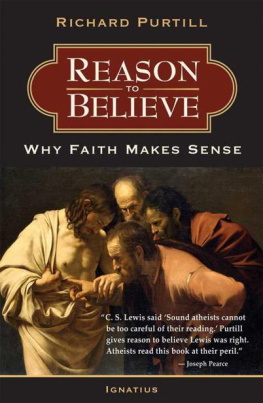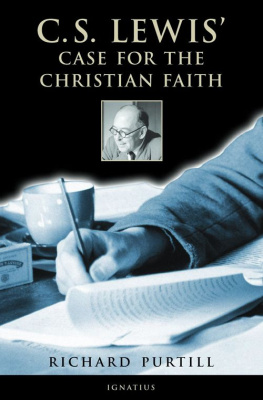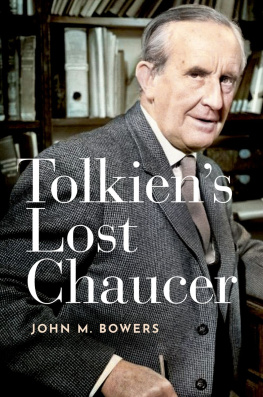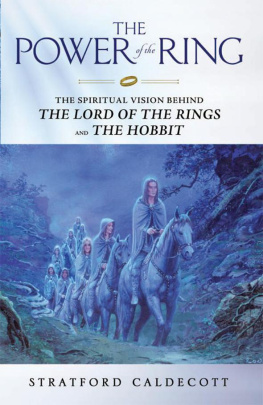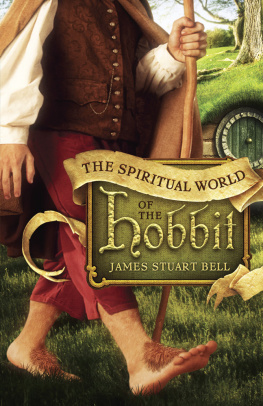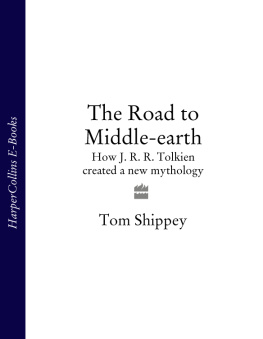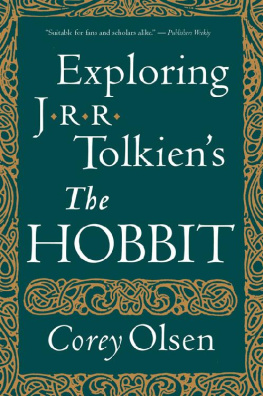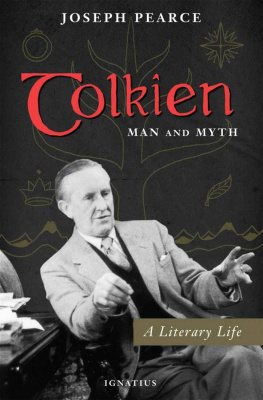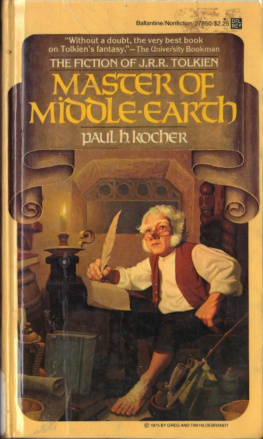J.R.R. TOLKIEN
Myth, Morality, and Religion
RICHARD L. PURTILL
J.R.R. TOLKIEN
Myth, Morality, and Religion
IGNATIUS PRESS SAN FRANCISCO
Original edition published in 1984 by
Harper & Row, Publishers, San Francisco
1984 by Richard L. Purtill
All rights reserved
New edition printed by permission of Richard L. Purtill
Cover art:
The Doors of Durin
(based on a drawing by J. R.R. Tolkien)
Cover design by Roxanne Mei Lum
Published in 2003 by
Ignatius Press, San Francisco
ISBN 0-89870-948-2
Library of Congress Control Number 2002112867
Printed in the United States of America
This book is dedicated
to all those who love the work of
J.R.R. Tolkien
but especially to my friend and former student
Gord Wilson,
who urged me to have
this book republished
CONTENTS
FOREWORD
It is an exciting time to be an admirer of the works of J.R.R. Tolkien. The release of Peter Jacksons three-part film adaptation of The Lord of the Rings has introduced millions of people to the mysteries and marvels of Middle Earth. Today, a half a century after the book was first published, The Lord of the Rings has a wider audience than ever. Its influence and impact on modern culture is immense.
What exactly is Tolkiens secret? Why has his myth about hobbits, elves, dwarves and men endured? Why has it stood the test of time so much better than the hundreds of so-called realistic novels published during the last century? Why does the oft-proclaimed relevance of these realistic novels appear so dated and irrelevant today? Why, on the other hand, does Tolkiens fantasy continue to attract new generations of readers? What exactly are the timeless qualities that make The Lord of the Rings so different from the many fading flowers of twentieth-century literature? Put simply and succinctly, why does Tolkien continue to be read while so many of his contemporaries are forgotten?
Questions such as these were at the heart of my own decision to write a book on Tolkien in the wake of his emergence as the Greatest writer of the twentieth century in several national surveys in the United Kingdom in 1997. Many critics responded to Tolkiens triumph with disdainful dismissiveness, one even going so far as to exclaim that the result merely illustrated the folly of teaching people to read. It was clear, however, that the ireful response of the critics, though vocal, was ultimately vacuous. Those sitting so superciliously in judgment on Tolkiens work had quite clearly not only misunderstood what the work was about but, far more reprehensibly, had never even considered it necessary to read the work before condemning it.
My own frustration at this willful ignorance was exacerbated by the absence (so I thought) of any work of literary criticism focusing primarily on the Christian dimension of The Lord of the Rings . I was aware of the excellent books by Tom Shippey and Verlyn Flieger detailing the richness of the linguistic dimension. Tolkien was, after all, a highly respected philologist and professor of Anglo-Saxon who drew deep draughts of inspiration from the well-spring of Christian cultural tradition. Yet Tolkien had insisted that his taste in languages, though important, was less significant to the writing of The Lord of the Rings than the fact that he was a Christian... and in fact a Roman Catholic. The religious dimension was, according to Tolkien himself, the most important of the really significant factors underpinning the moral vision of Middle Earth. Why, then, was there no published work discussing or highlighting the most significant element in the most successful book of the twentieth century?
Tolkien: Man and Myth , my own modest contribution to Tolkien studies, was written, therefore, as a reply and as a riposte to the ignorance of the critics and, more importantly, as a response to the perceived absence of any specifically Christian approach to The Lord of the Rings . For some reason that, even today, I cannot fully fathom, I remained unaware of the publication of Richard L. Purtills excellent book. I thought, evidently erroneously, that I had read all the major studies of Tolkien, and I do not know how, even during my research for Tolkien: Man and Myth , its existence escaped my attention. Had I known of Purtills book, which was originally published in 1984, my own would have been greatly enriched by the numerous insights that he presents. I am grateful, nonetheless, to have discovered the wealth of wisdom within its pages, albeit belatedly, and I am delighted that Ignatius Press have decided to re-publish it. It might not be a new book, strictly speaking, but as an old book renewed and resurrected it deserves pride of place amongst the new titles in the field of Tolkien studies.
In the wake of Jacksons film adaptation, there have been several new volumes exploring the Christian dimension in The Lord of the Rings . Some are shallow, though well intentioned; others, such as Bradley J. Birzers Sanctifying Myth , offer profound interpretations of Tolkiens mystical vision. Ultimately, however, none exceeds Purtills powerful analysis of the potency of Tolkiens sub-creation. Purtills exposition of the role of heroic free-will in Middle Earth, and his masterful illumination of the mysteries of myth, magic and miracle, will delight the initiated and enlighten the newcomer to Tolkiens world.
Appropriately enough, Purtill concludes eucatastrophicallythat is to say, he ends with a happy ending. His discussion of The Sudden Joyous Turn, or eucatastrophe, reminds us that Tolkiens vision is ultimately one of Christian faith, hope and love. It is, as Sam proclaimed in the darkness of Shelobs Lair, a light to you in dark places, or, as Frodo replied, a light when all other lights go out! It is, to echo Tolkiens own words, a glimmer of the promise of final victory in the midst of the Long Defeat of Fallen mans faltering history. For a Christian there is always hope, and Purtill guides us through the shadows of Tolkiens world into the timeless Light at the end of its tunnel. As we emerge bleary-eyed under Purtills guidance from the dimly-lit shadowlands of Middle Earth we realize with that sudden joyous turn that above all shadows rides the Sun....
Joseph Pearce
PREFACE
One of my qualifications for writing this book is a love of my subject. I first encountered J.R.R. Tolkiens The Hobbit on a library shelf when I was a child; I can still remember the look and feel of the book. I dipped into it and was immediately enchanted. It became one of my favorite books, and I returned to it periodically for rereading. I remember the thrill I felt years later when I read in the preface to C. S. Lewis book That Hideous Strength , Those who would like to learn further about Nmenor and the True West must (alas!) await the publication of much that still exists only in the mss. of my friend Professor J.R.R. Tolkien. There was more, then, of Tolkiens marvelous mythology, and someday it might be published.
It was a long waitfrom the forties to the sixtiesbut eventually I had another encounter on a library shelf: the three hardcover volumes of The Lord of the Rings . I remember that I took only the first volume, wondering if the fairytale atmosphere that so delighted me in The Hobbit could be sustained in so long a work. There was a hurried trip back to the library when I realized how much I was going to enjoy this story, but volumes two and three of the book were still on the shelves: this was before the Tolkien craze of the later sixties; indeed, it may have been before the publication of the first paperback editions.
I became a writer about Tolkien when in 1972 I received a summer grant from the National Endowment for the Humanities to do some research and writing. I had asked myself what I would really enjoy spending a summer thinking and writing about, and in my proposal I had outlined a book on Tolkien, C. S. Lewis, and Charles Williams. Williams proved too hard to write about together with the others, but I eventually did write the book: Lord of the Elves and Eldils: Fantasy and Philosophy in C. S. Lewis and J.R.R. Tolkien .
Next page
